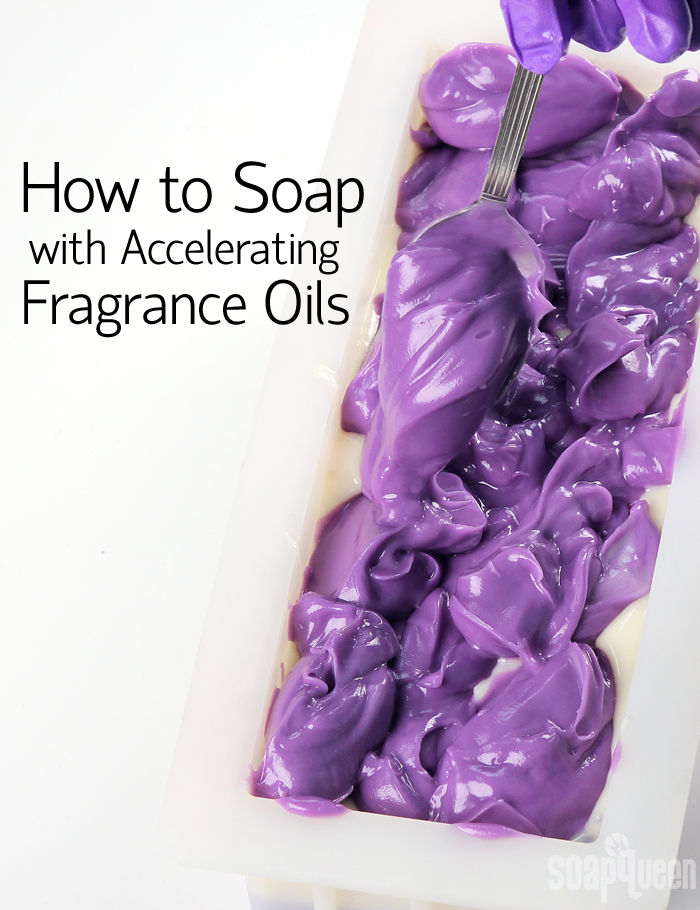
Last week, we put together a list of all the Bramble Berry Fragrance Oils that don’t cause acceleration. There are plenty to choose from, and I hope you find the list handy in the future! But, what if you fall in love with a fragrance and it accelerates? It doesn’t mean you can’t use it, but it does mean you may need to adapt your recipe in order to get the best results.
Tweaking your recipe to account for acceleration is a balancing act, and it takes practice. There are several aspects of the recipe you can change to make the acceleration more manageable, including changing the design and avoiding certain additives. If the fragrance accelerates slightly and you tweak the recipe to include more slow-moving oils, that can also counteract the acceleration. But if the acceleration is extreme enough, no recipe or method can prevent it. Acceleration depends on so many factors.
Change Your Design
Non-accelerating oils are necessary when you’re creating a design that requires lots of time to work. Techniques like the spin swirl, column pour and funnel pour require lots of pouring and movement. If the soap becomes thick and no longer fluid, the design just won’t work. When using an accelerating fragrance oil, choose your design carefully. Some designs actually work better with a medium to thick trace, making them perfect for that fragrance oil. Such designs are spoon plops, textured tops, lots of layers and designs with embeds.
If you’re determined to use an accelerating fragrance oil for a design that needs a well-behaving fragrance, sometimes you can get away with it if you tweak your recipe. But, I also recommend having a plan B in case the soap becomes thick. There have been many times I tried negate an accelerating fragrance oil with slow-moving oils, only to have it become pudding halfway through.
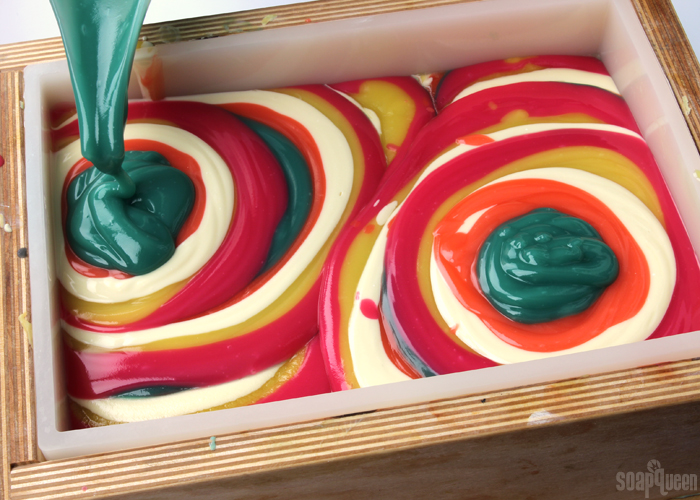 The Spin Swirl Technique is next to impossible with an accelerating fragrance oil. I learned this lesson when I tried to use Flower Child Fragrance Oil in the soap above. Notice it got too thick by the time I was done pouring!
The Spin Swirl Technique is next to impossible with an accelerating fragrance oil. I learned this lesson when I tried to use Flower Child Fragrance Oil in the soap above. Notice it got too thick by the time I was done pouring!
One instance that really stands out was attempting the spin swirl. I was determined to use Flower Child Fragrance Oil (which accelerates) for the Psychedelic Spin Swirl Cold Process Project. How perfect would that have been!? But, even using a recipe with plenty of slow-moving oils and working quick, my soap was thick halfway through. After two attempts, I threw in the towel and used a combination of Kumquat Fragrance Oil and Patchouli Fragrance Oil. It worked great. The end result was a bar that had the look I wanted and still smelled great. Moral of the story? Sometimes you have to compromise either the design or the fragrance. Changing the recipe doesn’t always solve everything.
Change Your Oils
Tweaking the oils in your recipe makes a huge difference in how long it takes for soap to thicken. Some oils are considered “slow-moving.” Generally, these oils are lightweight and liquid at room temperature, like olive oil, rice bran oil, sweet almond oil and canola oil. If the oil or butter is solid at room temperature like palm oil, coconut oil, cocoa butter, etc., you can assume it will make your soap thicken more quickly.
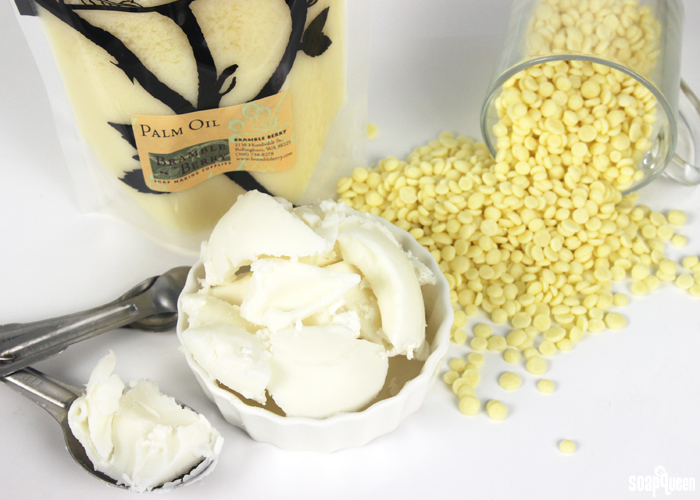 Firm oils like palm oil, coconut oil and butters tend to speed up trace.
Firm oils like palm oil, coconut oil and butters tend to speed up trace.
When working with an accelerating fragrance oil, I plan my recipe around it and include more slow-moving oils than normal. I may avoid butters, because they can be a little bit more temperamental. I definitely stay away from beeswax and also soap with castor oil at 3% or less in the recipe. I have found that more than 3% castor in my recipe tends to speed up trace slightly. If I’m trying to avoid acceleration, my recipes are usually about 60% or more slow-moving oils, and 40% or less fast-moving oils.
Change Your Temperatures
The temperature of your lye solution and oils affects soap in many ways. For most soapers, the preferred temperature of soaping lye and oils is about 120-130 ° F. In general, warmer soaping temperatures speeds up trace, causing soap to become thick more quickly. If I’m creating a design that requires a lot of time to work, I tend to soap a little bit cooler than normal, around 100-120 ° F. If your recipe is moving a little bit faster than you’d like, try decreasing your soaping temperatures by 10-15 ° F. It can make a huge difference!
Change Your Additives
Some ingredients cause acceleration. If you’re using a fragrance that accelerates and want to prevent it as much as possible, skip these additives. Ingredients that contain sugar like honey, beer, wine, milk and purees increase temperature, which can speed up trace. Salt also speeds up trace, whether it’s added to the lye water (as shown here) or at trace (as shown here). Interestingly, I’ve found that sodium lactate (which is type of salt), doesn’t have a huge effect on trace when used at the correct usage rate. I use it in every single recipe, including recipes with accelerating fragrances and more complicated designs.
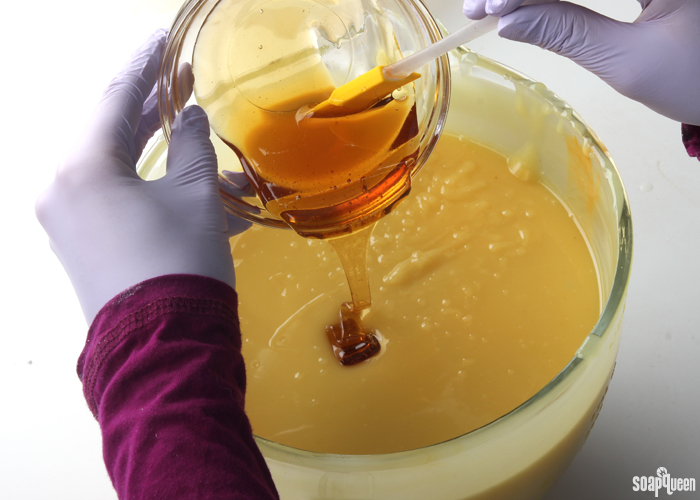 Additives with sugar (like honey) cause temperatures to increase, which will accelerate trace.
Additives with sugar (like honey) cause temperatures to increase, which will accelerate trace.
Ingredients that are known for their absorption properties also speed up trace. Such ingredients include clays, activated charcoal and titanium dioxide. Dispersing clay and other absorbing ingredients in distilled water can help negate some of the acceleration, but avoiding them completely is the best way to prevent acceleration.
Put Down the Stick Blender
Accelerating or not, I whisk in just about every fragrance oil at the very end. If I don’t care about the soap becoming thick, I might stick blend the fragrance oil in. But, if I’m trying to avoid acceleration at all costs, I put my stick blender down and use it very sparingly. Using the stick blender accelerates soap, because it speeds up the emulsification process. The fragrance oils at Bramble Berry are tested by whisking in the fragrance into the batter. If you choose to use the stick blender instead, be ready for the batter to become thicker whether or not you’re using an accelerating fragrance oil. =)
Avoid the Water Discount
Water discounting your recipe has a lot of benefits. It helps soap release from the mold faster and prevents glycerin rivers. But, removing water from the recipe causes soap batter to thicken more quickly. A water discount combined with an accelerating fragrance oil can lead to some pretty thick soap very quickly. If you’d like to learn more about how to water discount your soap and how it affects your batch, check out this post.
When you’re working with an accelerating fragrance oil, how do you tweak your recipe or design? Or, do you embrace the acceleration and use it to your advantage with textured tops, layers, etc.?




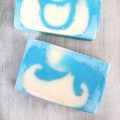
Hi! After a month of stocking up knowledge from you guys, I finally made my first CP soap loaf today. I added my fragrances last to my batters. Rose FO to my pink, and Vanilla FO to my brown batter. The pink batter accelerated soooo fast!! I had to pour both quickly and alternately in the mold, and then when I swirled into it using a skewer, the pink is definitely forming really thick while the brown doesn’t. I am now very anxious of what it would look like when I unmold it. Do you have any tips for me? Can I unmold it tomorrow? Is it going to be terrible? 😰
Your soap will still definitely turn out and I think it will still look nice too. You mat want to give the soap 48 hours before unmolding depending on what type of mold you used.
Thanks so much Terah! I used a silicone mold for it. But I noticed droplets of oil (or is it FO?) seeping out at the top of my batch. The soap re-absorbed it yesterday, but this morning it has droplets again. I put the soap in an airconditioned room at night because it’s very tropical here in the Philippines, but during the day it’s in room temp. Kinda warm. Is that what causes the droplets?
-btw, I thank God everyday for Brambleberry and all your contribution to soap world. You guys are amazing!!! ☺️🎉
Thank you so much for this sharing. My first batch of cold process soap making was a total failure as the mixture thickened quickly only I added the fragrance and to make things worse I used the stick blender. I was totally disappointed but I’m still hoping for a success story on my next round!
You’re welcome Saandhi! It definitely can take some patience getting started but it sounds like you’re doing great.
As I am new to Cold Process Soap making, this helps tremendously!!!!
Thank you so much!!!
You’re welcome, glad to hear it Daffney.
Hello Bramble berry team!
I’m from Québec Canada and I realise we do not have sites like Bramble berry here in Québec that gives free tutorials and tips like you guys do. I made my first batch of soap a couple weeks ago…already addicted….since then I’ve been reading your website everyday and can’t go to bed early because I find new informations over and over and learning so much with all these interesting tutorials. I’m VERY grateful. Just all of your answers to questions shows us how y’all like your jobs and the teaching your providing. Thanks for give me the chance to learn so much!!
Oh absolutely Pam, we love sharing what we learn. Thanks so much for your kind comment. We appreciate it.
Having been frustrated so many times with accelerating FOS I set about solving this problem. I increase the water by 10% and freeze it. Then I mix in the lye like for milk soap. I have my oils at 110 degrees. I blend to a light trace then whisk in colors and FO. This solves the problem beautifully.
Great tips, thanks Jane. More water and cooler temperatures can definitely help.
Thanks for sharing, Keep bringing more!!
You’re welcome Aadila. 🙂
Here’s my dilemma. I have a couple fragrances that always cause my soap to crack a within 3 hours after pouring from excess heat (and also accelerate trace). I already use a water discount because it keeps gel temperatures lower, which I assumed would reduce the likelihood of cracking. In this article you recommend using more water with accelerating fragrances but wouldn’t that cause overheating when the fragrance is already causing it to heat? Or do you assume people are refrigerating recipes that accelerate? I equate acceleration with overheating. Is that wrong?
Acceleration and overheating don’t always go together. Fragrances can still accelerate if you’re using cooler temperatures. Adding more water can slow the fragrance down, as water discounts accelerate trace. If you prefer a water discount, putting the soap in the fridge for 5-24 hours will help. That will ensure everything stays cool and will help prevent the cracking.
I was wondering, if I do not plan to do any swirls or fancy designs, maybe just one pink color for the whole batch, could I pour it on loaf mold and then add fragrance oil and mix there once on mold? I was thinking as an added measure to the above ones.
I would recommend mixing your fragrance in the bowl – it’s a lot easier to get it incorporated than trying to mix in the mold. Once you have your color all mixed in, add your fragrance, whisk to fully incorporate, and get the soap in the mold. You should have a good amount of time to do that with a simple design.
You missed one very simple way to slow down those tricky fragrance oils that speed up trace – add them to your oils before you add your lye. Then it’s much easier to control how fast or slow your soap is thickening (and you can also make sure that the FO is fully incorporated).
In our tests and recipes, we’ve found that can speed up trace a bit faster than usual. Once you start stick blending the soap, the fragrance will begin to accelerate. You can definitely use that method if you’re familiar with how the fragrance works with your recipe though! Soaping is a lot of personal preference and everybody’s method varies slightly. 🙂
-Kelsey with Bramble Berry
Here’s a quick question regarding this post. I know apple jack does accelerate and sometimes rice if you’re not careful. Do you know how apple jack would perform in hot process soap? I always use the “bad boys” for cold process in hot process and have no issues. My main concerns are if it would rice or heat it up and cause it to volcano. Of course, it is added at the end of the cooking.
Thank you!
I wouldn’t recommend Applejack Peel for hot process. At temperatures over 120F, it can rice and separate. Because hot process soap is around 160F, that can cause some issues. I would recommend it instead for cooler cold process recipes. 🙂
Applejack Peel Fragrance Oil: https://www.brambleberry.com/Applejack-Peel-Fragrance-Oil-P3905.aspx
-Kelsey with Bramble Berry
Thank you for this awesome post! I’ve been trying to master the funnel drop technique, which needs totally thin trace for quite a while, but my soap has always thickened before I got to the end. I’ve tweaked the recipe and checked temperature, but you’ve given me more tips to try, like no water discount and not stick blending. I’m surprised though that sodium lactate doesn’t affect trace. Good to know!
You’re welcome Jackie, glad you found this helpful! I think no water discounting and whisking the fragrance in will really help. 🙂
-Kelsey with Bramble Berry
Thank you so much! I’ve only been making soap for three months and the 100% coconut oil soap completely seized on me after adding essential oils. I didn’t know what to do. This article is very helpful, thank you.
You’re welcome Sharon, glad the post is helpful for you! It can also help to warm the essential oils for coconut oil soap. That will prevent cooler ones from solidifying the coconut oil. 🙂
-Kelsey with Bramble Berry
Another great article! If I want to do anything fancy with a fragrance that accelerates, I will just very briefly stick blend and then wisk until it emulsifies but doesn’t trace. Then I add my colorants etc and add fragrance last. As you say, it depends on all the various factors as to how successful it is, but I usually have time to work without panic. Or, I will simply make castile soap and that also gives lots of room to work. The trick is to barely have trace when you start then be ready to work until you finish! You have to have your colors, containers, and mold ready to go.
Those are great tips Michael, thanks for sharing! 🙂
-Kelsey with Bramble Berry
This is a great article, as always and I have two suggestions. As previously mentioned, always have a plan B even if you are not expecting acceleration. I love the spoon plop when I plan it and as a plan B when my soap accelerates unexpectedly. Also, if you are using a scent that you know will accelerate, you can always do a hot process batch. You add the scent at the end of the cook so it is not an issue.
Thanks Eric, glad you enjoyed the article! Having a plan B is always a good idea. 🙂
-Kelsey with Bramble Berry
Wonderful article!! 🙂 💜 No matter what, always have a plan B! Soap has a mind of it’s own! Embrace it!!
Absolutely! I’ve had to switch to spoon plops a couple times and have gotten really beautiful results. 🙂
-Kelsey with Bramble Berry
This is a perfectly timed post for me. I’m not sure if I can entirely blame the fragrance oils however. I am a poster child of what NOT to do when trying to make soaps with a swirl. I realized part way through Saturday’s experiment that hemp seed oil turns things seriously green so I’d better use titanium dioxide to lighten things (Mistake number 1). I used red Brazilian clay to redden things up. (Mistake number 2). I used untested fragrance oils. (Mistake number 3.). I forgot to add the fragrance oils until trace had occurred and was not slowing down any time fast. (Mistake number 4.). I used palm kernel flakes AND coconut oil. (Mistake number 5.)
Tonight when I tried to unmold, it wasn’t happening. Although it smells divine, I fear I have another mess on my hand. To date I have never made a successful swirl. Guess I’ll be keeping my day job for awhile.
Oh I’m sorry about that Sarah! I can tell you all soapers have definitely been there. When you’re first starting to work with swirls it can be tricky to get trace just right. The great news is you have all this knowledge for your next batch, so it’s going to go a lot more smoothly! Also, is your batch pretty soft now? How long has it been in the mold? Let me know and I can help you out. 🙂
This post has some helpful swirling tips: https://www.soapqueen.com/bath-and-body-tutorials/tips-and-tricks/five-tips-swirling-cold-process-soap/
-Kelsey with Bramble Berry
This is what I love about Bramble Berry: The teaching side of soap and cosmetics. I’ve only been making soap for two years. Researching tutorials has helped me save batches and money. Thanks for all your help.
You’re very welcome Suzette! We love helping people, so your comment really means a lot to us. Thank you so much. 🙂
-Kelsey with Bramble Berry